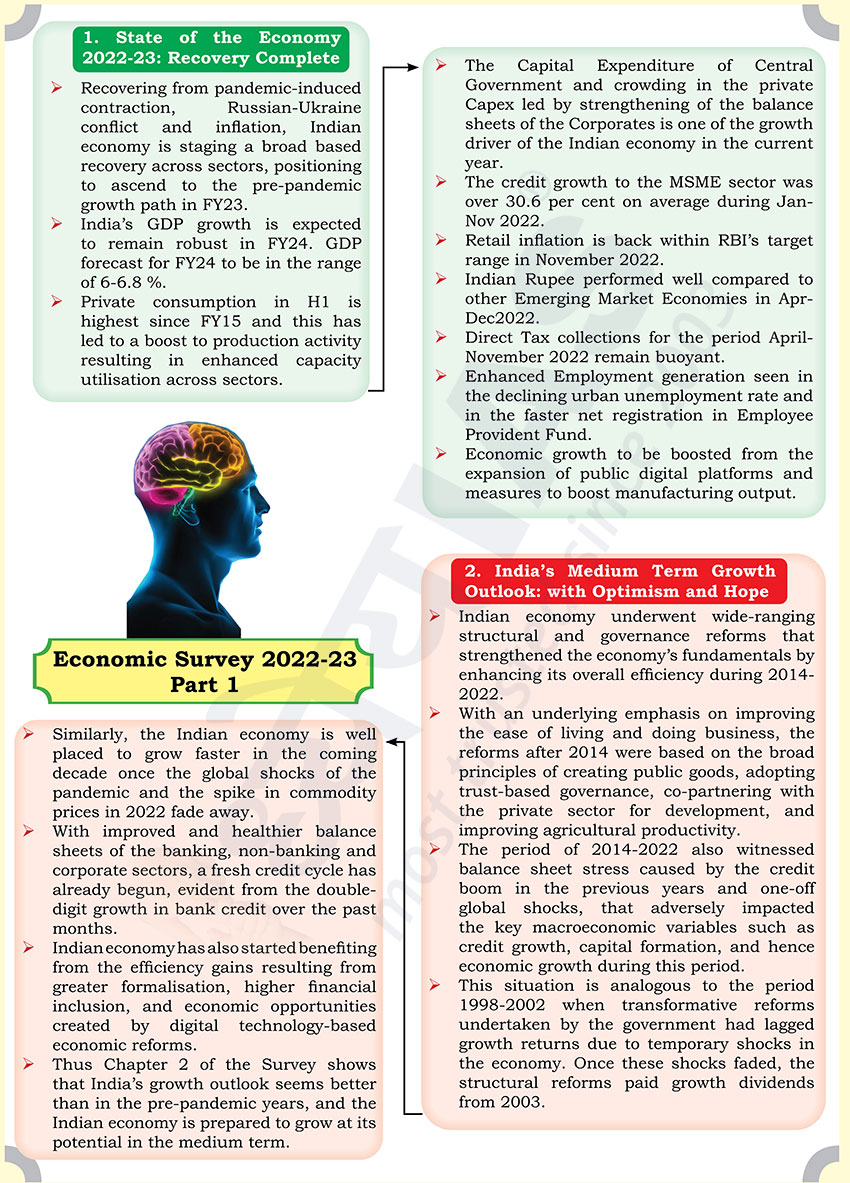Brain-booster /
21 Feb 2023
Brain Booster for UPSC & State PCS Examination (Topic: Economic Survey 2022-23 - Part 1)

State of the Economy 2022-23: Recovery Complete
- Recovering from pandemic-induced contraction, Russian-Ukraine conflict
and inflation, Indian economy is staging a broad based recovery across
sectors, positioning to ascend to the pre-pandemic growth path in FY23.
- India’s GDP growth is expected to remain robust in FY24. GDP forecast
for FY24 to be in the range of 6-6.8 %.
- Private consumption in H1 is highest since FY15 and this has led to a
boost to production activity resulting in enhanced capacity utilisation
across sectors.
- The Capital Expenditure of Central Government and crowding in the
private Capex led by strengthening of the balance sheets of the Corporates
is one of the growth driver of the Indian economy in the current year.
- The credit growth to the MSME sector was over 30.6 per cent on average
during Jan-Nov 2022.
- Retail inflation is back within RBI’s target range in November 2022.
- Indian Rupee performed well compared to other Emerging Market Economies
in Apr-Dec2022.
- Direct Tax collections for the period April-November 2022 remain
buoyant.
- Enhanced Employment generation seen in the declining urban unemployment
rate and in the faster net registration in Employee Provident Fund.
- Economic growth to be boosted from the expansion of public digital
platforms and measures to boost manufacturing output.
India’s Medium Term Growth Outlook: with Optimism and Hope
- Indian economy underwent wide-ranging structural and governance reforms
that strengthened the economy’s fundamentals by enhancing its overall
efficiency during 2014-2022.
- With an underlying emphasis on improving the ease of living and doing
business, the reforms after 2014 were based on the broad principles of
creating public goods, adopting trust-based governance, co-partnering with
the private sector for development, and improving agricultural productivity.
- The period of 2014-2022 also witnessed balance sheet stress caused by
the credit boom in the previous years and one-off global shocks, that
adversely impacted the key macroeconomic variables such as credit growth,
capital formation, and hence economic growth during this period.
- This situation is analogous to the period 1998-2002 when transformative
reforms undertaken by the government had lagged growth returns due to
temporary shocks in the economy. Once these shocks faded, the structural
reforms paid growth dividends from 2003.
- Similarly, the Indian economy is well placed to grow faster in the
coming decade once the global shocks of the pandemic and the spike in
commodity prices in 2022 fade away.
- With improved and healthier balance sheets of the banking, non-banking
and corporate sectors, a fresh credit cycle has already begun, evident from
the doubledigit growth in bank credit over the past months.
- Indian economy has also started benefiting from the efficiency gains
resulting from greater formalisation, higher financial inclusion, and
economic opportunities created by digital technology-based economic reforms.
- Thus Chapter 2 of the Survey shows that India’s growth outlook seems
better than in the pre-pandemic years, and the Indian economy is prepared to
grow at its potential in the medium term.







